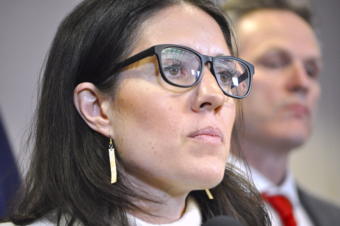
Health officials have been transitioning Alaska’s COVID-19 vaccine distribution process, from delivering directly to hospitals and clinics to a more decentralized system which relies on pharmacies and individual doctors’ offices.
The vaccine supply is still very limited, but there’s also a bottleneck in the number of health care providers who’ve gotten through the enrollment process to offer vaccinations.
If you work in the private health care system, there’s extra training and tests, complicated logistics so vaccines don’t warm up and get ruined, and serious data entry.
“It’s required a lot more than a typical vaccine,” said Tiffany Foss, a certified nurse aide and vaccine coordinator at Family Practice Physicians in Juneau.
Foss thinks she’s done five exams and multiple trainings so far — and the vaccines haven’t been delivered yet.
“Every other day it seems like there’s something else that’s also required in order to obtain the vaccine,” she said. “So, definitely overwhelming at some points, but I’m glad they’re being as thorough as they are being with it.”
Foss said she thinks her practice will get some vaccines in February.
State Immunization Program Manager Matt Bobo said Friday there are 420 providers enrolled as vaccinators, but they’re not all offering appointments right now. A lot of potential COVID-19 vaccinators aren’t ready, are opting not to, or don’t have vaccines yet.
There are a lot of disincentives, said Alaska’s Chief Medical Officer, Dr. Anne Zink.

“If you’re not a regular vaccinator? You know, it’s a complex process. It’s hard to figure out initially how to do VacTrAK.”
That’s the system for ordering vaccines and tracking their distribution.
“It’s not like a flu vaccine that is a one-dose,” Zink said. “It’s very finicky. It has to be stored at the right temperatures. It has to be used in a certain period of time. We have to track what goes in and comes out. There’s a lot of processes to that. And so, particularly those that don’t vaccinate regularly, it’s a big lift.”
There’s also an exhaustion factor.
“These are also people who have been, you know, sprinting since last year,” she said. “To completely changing their entire worlds trying to figure out how to test, how to respond, worrying they were gonna die … There are some clinics that say, ‘I can’t. I just can’t. I don’t have the space and capacity to do this anymore.’”
Vaccinators also must agree to administer it to anyone eligible. Right now, that’s people 65 and up and frontline health care workers.
Nurse practitioner Lauren Hopson said that’s a snag where she works at Glacier Pediatrics in Juneau. They only treat children: To limit traffic at their clinic, they don’t want to order any vaccine until at least some of their patients are eligible.
Zink and other public health officials have said it’s an imperfect system.
Kevin Berry is an economist at the University of Alaska Anchorage who’s studied the economics of social distancing and pandemics since around 2012. When COVID-19 swept the globe, he had very mixed feelings.
“It was like, ‘Finally, I’m relevant!’ Because nobody read any of my work about how to stop it.”
Because the federal government failed to plan and support a coordinated vaccination campaign — for example, Army medics and National Guard members could have been trained for mass vaccinations — this may now be the best way, he said.
“That needed to happen before we got to this point,” Berry said. “Not now. So, I think you’re thinking about the largest body of people who can administer vaccines quickly and safely.”
Berry’s concerned that if vaccination goes too slowly, risk that it will fail increases, especially as faster spreading coronavirus variants emerge, like the one out of the United Kingdom. When “preventable spread” isn’t prevented, he said, it’s like COVID-19 takes extra rolls of the dice.
“As far as mutations that can make the disease worse. And so, this movement to the private sector that gets the vaccines in people’s arms faster is good, because it reduces the risk that we’re gonna wind up in trouble with a new variant of the disease that is even worse than what we’ve seen so far.”
And of course, there are reasons for providers to step up, too. They want to help their patients and communities. And — individual health care workers who volunteer in an upcoming mass vaccination event would themselves become eligible to receive the vaccine.
Jeremy Hsieh is the deputy managing editor of the KTOO newsroom in Juneau. He’s a podcast fiend who’s worked in journalism since high school as a reporter, editor and television producer. He ran Gavel Alaska for 360 North from 2011 to 2016, and is big on experimenting with novel tools and mediums (including the occasional animated gif) to tell stories and demystify the news. Jeremy’s an East Coast transplant who moved to Juneau in 2008.





